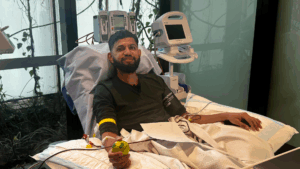Aadil is 30, works in HR data analytics, and recently became a dad. A few months ago, he became something else too. A stem cell donor. We are very grateful Aadil let us interview him to talk about stem cell donation.
He didn’t know much about donating stem cells. Like many people, he heard about it when he was giving blood. But there is another way to join the Aussie stem cell registry. All it takes is a few simple cheek swabs. Sign up online and a cheek swab kit will be mailed to your home. Simple.
You may never come up as a match, in fact most people never will. but a few months later, Aadil got the call.
He was a match for someone who needed donated stem cells to survive.
He was surprised. Pleasantly surprised.
Why Aadil said yes
When asked why he was happy to donate, Aadil said:
“I think it’s something that it’s almost hard to process that you can make that much of a big difference in someone’s life. It’s not something you get to do every day. You can give your time or your money, everyone can do that. But for you, specifically, to give something that only you can, to save someone’s life, it’s an amazing thing to be able to do..”
What’s it really like donating stem cells?
For most people, the process is like a long plasma donation.
Aadil had a series of injections in the days leading up to his donation. These helped his body release extra stem cells into his bloodstream. Then he spent a few hours at the Kinghorn Cancer Centre in Sydney, where the stem cells were collected from his blood using an apheresis machine. Blood comes out from one arm, the stem cells are collected, and the rest of the blood is returned through the other arm.
“It’s honestly just like a long plasma donation. A few jabs in the days leading up to it, then you just sit here for a few hours. You can watch something, read something, and then that’s it.”
It usually takes four or five hours to collect the stem cells.
Side effects and injections
Like many people, Aadil experienced a few side effects from the injections. He had some aches and pains in his lower back, thighs, and shoulders, plus a few headaches.
“Maybe you feel a little bit off for a couple days before, but it’s nothing that major. And if you consider what you’re potentially doing for someone, I think it’s totally worth it.”
He said a couple of simple paracetamol tablets helped ease the aches and got him through.
Aadil chose to self-inject the medication, which is one of the two options available to donors. The other is to have a nurse do it.
He admitted it felt confronting at first, but it got easier each time.
“The first time, I was like, oh my God, I have to do this. What’s the right angle? Is it going to hurt? But once I’d done it, I realised it was worse in my head than in real life. It barely hurts. The needle is very sharp and goes straight in. The next few times were fine.”
Why diversity matters
At the time he signed up, Aadil didn’t realise how important his ethnic background might be to someone needing a transplant. He thought it was just about blood type.
Learning the truth came as a bit of a shock.
You can only donate to someone with the same ethnic background or mix of backgrounds.
Right now, more than 80 percent of Australian patients needing donated stem cells for conditions like blood cancer rely on overseas registries to find a match. That is mostly because the local Aussie registry doesn’t reflect the country’s diversity.
Aadil’s donation went to someone with a similar ethnic background to his own.
“I had no idea diversity mattered so much. I didn’t realise how few people from my community were actually on the registry. That really hit me.”
Now he’s speaking to his friends and community to raise awareness. He knows that if more people sign up, more lives can be saved.
Want to be a stem cell donor?
If you are thinking about signing up, you need to be:
– aged between 18 and 35
– generally healthy
– an Australian citizen or permanent resident
– willing to donate to anyone, anywhere in the world (you will not have to leave the country, but your stem cells might)
You can sign up online in under five minutes. A cheek swab kit will be mailed to you. Just follow the instructions and remember to post it back.
Joining the stem cell registry is completely separate from donating blood or plasma, but we encourage people to do that as well. It all helps save lives.
Aadil is a legend. You could be too.
By joining the stem cell registry, you could be the one person in the world who can help someone like Aadil’s recipient. Someone’s life could depend on you.
Learn more
If you’d like to find out more about stem cell donation and how The TLR Foundation is working to recruit more young and diverse donors, visit our page.
